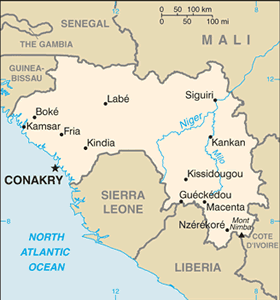The Geography of Guinea
The Geography of Guinea
Guinean Geography
Location: Western Africa, bordering the North Atlantic Ocean, between Guinea-Bissau and Sierra Leone
Geographic coordinates: 11 00 N, 10 00 W
Map references: Africa
Area: total: 245,857 sq km land: 245,857 sq km water: 0 sq km
Area - comparative: slightly smaller than Oregon
Land boundaries: total: 3,399 km border countries: Cote d'Ivoire 610 km, Guinea-Bissau 386 km, Liberia 563 km, Mali 858 km, Senegal 330 km, Sierra Leone 652 km
Coastline: 320 km
Maritime claims: territorial sea: 12 nm exclusive economic zone: 200 nm
Climate: generally hot and humid; monsoonal-type rainy season (June to November) with southwesterly winds; dry season (December to May) with northeasterly harmattan winds
Terrain: generally flat coastal plain, hilly to mountainous interior
Elevation extremes: lowest point: Atlantic Ocean 0 m highest point: Mont Nimba 1,752 m
Natural resources: bauxite, iron ore, diamonds, gold, uranium, hydropower, fish, salt
Land use: arable land: 4.47% permanent crops: 2.64% other: 92.89% (2005)
Irrigated land: 950 sq km (2003)
Natural hazards: hot, dry, dusty harmattan haze may reduce visibility during dry season
Environment - current issues: deforestation; inadequate supplies of potable water; desertification; soil contamination and erosion; overfishing, overpopulation in forest region; poor mining practices have led to environmental damage
Environment - international agreements: party to: Biodiversity, Climate Change, Climate Change-Kyoto Protocol, Desertification, Endangered Species, Hazardous Wastes, Law of the Sea, Ozone Layer Protection, Ship Pollution, Wetlands, Whaling signed, but not ratified: none of the selected agreements
Geography - note: the Niger and its important tributary the Milo have their sources in the Guinean highlands


